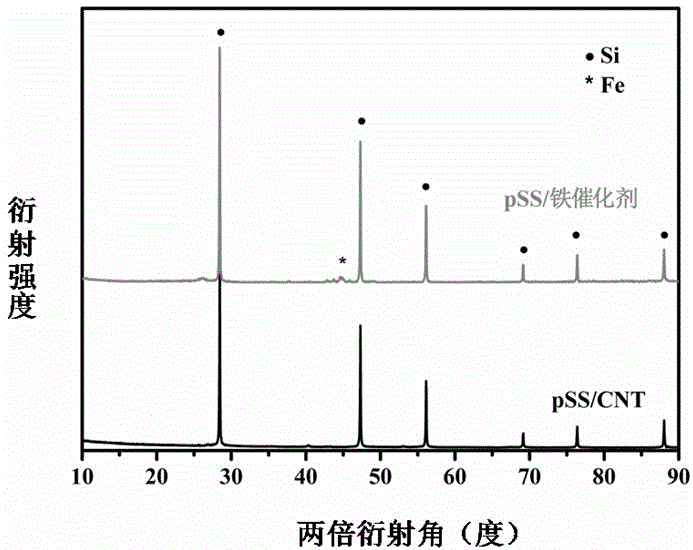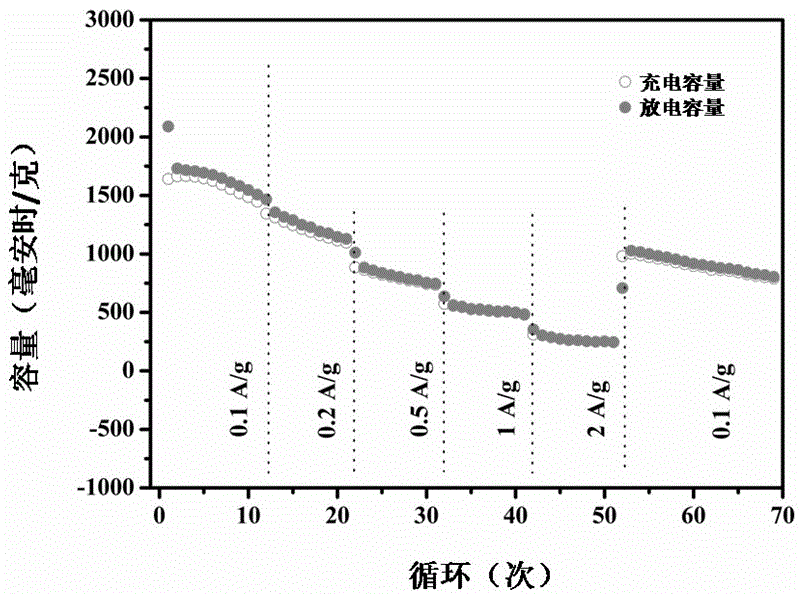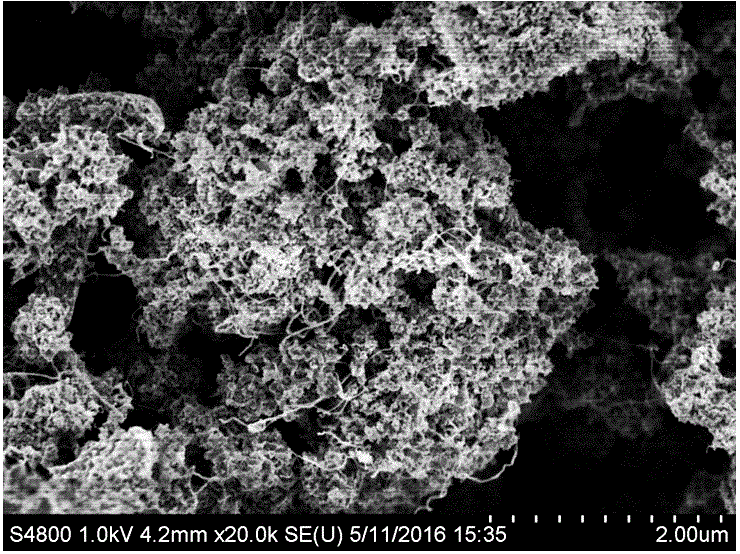Preparation method of carbon nanotube composite porous silicon anode material for lithium ion battery
A carbon nanotube composite and lithium-ion battery technology, which is applied to battery electrodes, secondary batteries, circuits, etc., to achieve the effects of simple equipment, alleviating volume stress, and increasing electrical contact points
- Summary
- Abstract
- Description
- Claims
- Application Information
AI Technical Summary
Problems solved by technology
Method used
Image
Examples
Embodiment 1
[0031] (1) Weigh 10 g of silica with a particle size of 200 nm and 15 g of magnesium powder of 250-300 mesh, put them in an agate mortar and grind them evenly, then put the mixed powder in a corundum crucible, and place in a tube furnace Inside, nitrogen was used as a protective gas, and sintered at a high temperature of 700 ° C for 6 h to obtain powders of porous silicon and its by-products;
[0032] (2) Use hydrochloric acid to remove unreacted magnesium powder and by-product magnesium oxide from the powder obtained in (1), and dry to obtain pSS;
[0033] (3) Mix the pSS obtained in (2) and ferrous sulfate in water and evaporate the water to dryness. Then put the mixture powder in a tube furnace, pass hydrogen as the reducing gas, and sinter at 700 °C for 6 h at a high temperature to obtain porous silicon loaded with iron catalyst;
[0034] (4) Put the porous silicon loaded with iron catalyst obtained in (3) in a tube furnace, pass a mixed gas of methane and nitrogen for 1-...
Embodiment 2
[0037] (1) Weigh 5 g of silica with a particle size of 7 nm and 4.5 g of magnesium powder of 100-200 mesh, place them in an agate mortar and grind them evenly, then place the mixed powder in a corundum crucible, and place in a tube furnace Inside, the mixed gas of hydrogen and argon is used as the protective gas, and the powder of porous silicon and its by-products is obtained by sintering at a high temperature of 550 °C for 10 h;
[0038] (2) Use hydrochloric acid to remove unreacted magnesium powder and by-product magnesium oxide from the powder obtained in (1), then use hydrofluoric acid to remove unreacted silicon dioxide, and dry to obtain pSS;
[0039] (3) Mix the pSS obtained in (2) and ferric nitrate in a mixed solution of water and ethanol and evaporate to dryness. Then put the mixture powder in a tube furnace, pass hydrogen and argon mixed gas as reducing gas, and sinter at 500 °C for 8 h at a high temperature to obtain porous silicon loaded with iron catalyst;
[0...
Embodiment 3
[0043] (1) Weigh 1 g of silica with a particle size of 100 nm and 1.2 g of magnesium powder of 100-200 mesh, put them in an agate mortar and grind them evenly, then put the mixed powder in a corundum crucible, and place in a tube furnace Inside, argon was used as a protective gas, and sintered at 950 °C for 2 h at a high temperature to obtain powders of porous silicon and its by-products;
[0044] (2) Use nitric acid to remove unreacted magnesium powder and by-product magnesium oxide from the powder obtained in (1), then use hydrofluoric acid to remove unreacted silicon dioxide, and dry to obtain pSS;
[0045] (3) Mix the pSS obtained in (2) with ferric chloride in a mixed solution of water and isopropanol and evaporate to dryness. Then put the mixture powder in a tube furnace, pass carbon monoxide as a reducing gas, and sinter at 900 °C for 2 h at a high temperature to obtain porous silicon loaded with iron catalyst;
[0046](4) Put the porous silicon loaded with iron cataly...
PUM
| Property | Measurement | Unit |
|---|---|---|
| Particle size | aaaaa | aaaaa |
| Particle size | aaaaa | aaaaa |
| Particle size | aaaaa | aaaaa |
Abstract
Description
Claims
Application Information
 Login to View More
Login to View More - R&D
- Intellectual Property
- Life Sciences
- Materials
- Tech Scout
- Unparalleled Data Quality
- Higher Quality Content
- 60% Fewer Hallucinations
Browse by: Latest US Patents, China's latest patents, Technical Efficacy Thesaurus, Application Domain, Technology Topic, Popular Technical Reports.
© 2025 PatSnap. All rights reserved.Legal|Privacy policy|Modern Slavery Act Transparency Statement|Sitemap|About US| Contact US: help@patsnap.com



